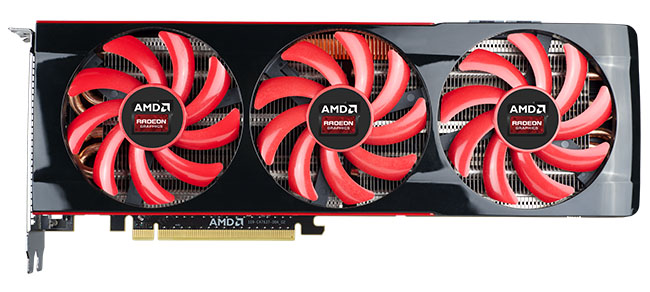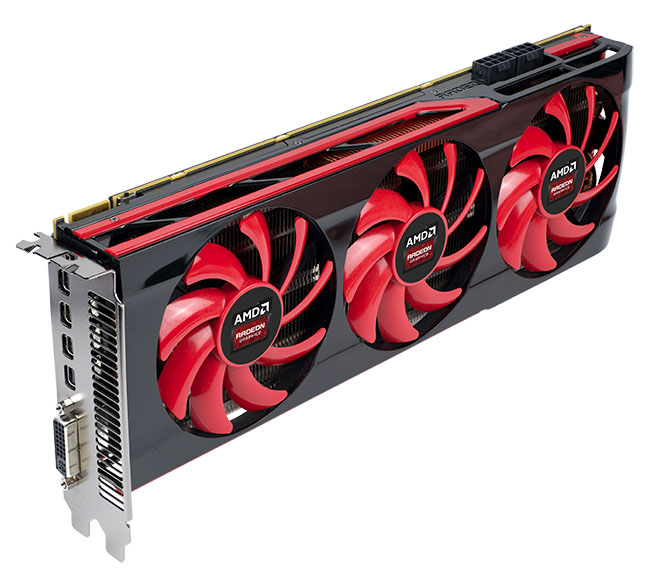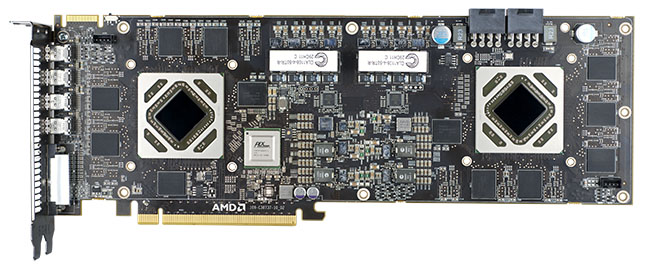Lusty graphics
It's a known fact that AMD partners have faced significant form-factor challenges when developing their own HD 7990 cards. We've yet to see one that doesn't span at least three PCI(e) slots and is so physically massive as to make a GeForce GTX 690 look small in comparison.
The near-universal praise heaped upon NVIDIA for the striking industrial design of the GTX 690 and TITAN cards may be one reason why AMD has taken a while to get its own Radeon HD 7990 ready for public consumption. The company desires a card that's as sublime as it is fast.
We're impressed that AMD has been able to shoehorn such power into a card that takes up a standard dual-slot form factor. But getting rid of the inevitable heat build-up is no easy task, so the HD 7990's cooler matches the 12in PCB. Subjectively speaking, as nice as this card looks and feels, NVIDIA's GeForce GTX 690 is in a different league in terms of construction.
A trio of fans sit on top of a cooler that can only be described as massive. The card can pull 375W when going like the clappers, according to AMD, intimating the cooler has a serious amount of work to do. The quoted TDP infers that it's sensible to have a PSU with at least 600W on tap and plenty of oomph on the 12V line.
Construction is excellent and the heft is such that it'll make a good weapon once you tire of playing games. Interestingly the cooler isn't a completely enclosed design, per NVIDIA's two high-end cards, and there's ample opportunity for very hot air to be pushed out of the sides and into the chassis.
AMD carries over the BIOS-toggling switch first seen on select Radeon 6000-series cards. Alongside is a single CrossFire connector that paves the way for two-card, four-way XF usage. Look further down and the two 8-pin power connectors inform you indirectly that this is a card built for performance above all else.
Two Radeon 7970 GHz-like GPUs are kept well apart and mounted at slightly different heights on the long PCB that has a card-wide heatsink on the underside. Our fingers can vouch for the fact that it becomes rather toasty when in use.
Overall design is well-executed but fairly standard until you look at the IO section. AMD is acutely aware that these types of cards are more than likely to be used in conjunction with multiple monitors. We've often bemoaned that a regular Radeon output setup isn't as good as NVIDIA's - running multiple screens is tricky, to say the least - so AMD outfits the HD 7990 with a dual-link DVI port alongside four mini-DisplayPorts that hark back to the days of the Eyefinity Editions.
The premise behind the choice of outputs is to enable easier multi-screen gaming, says AMD. Trouble is, DisplayPort hasn't caught on for the majority of cheaper full-HD monitors and, if using active DP-to-DVI adapters, costing £20 a pop, you can 'only' run them on two of the four mini-DP ports. We can see the logic behind the use of mini-DP outputs but encourage add-in board partners to do the right thing and bundle in a couple of necessary adapters.
Here's where AMD takes a leaf out of the NVIDIA dual-GPU playbook. Note the PLX bridging chip in the middle? It's the same PEX 8747 as found on the GTX 690. On a technical standpoint it connects to each Radeon GPU over a x16 PCI Gen 3.0 interface and to the CPU via another x16 link - matching what's on offer from an Intel Ivy Bridge CPU - making 48 lanes in total. The memory, meanwhile, is the same Hynix stuff present on the HD 7970 GHz Edition... and it runs at the same speed, as well.
Suitably impressive on paper and looking the business, let's see if it outwit the GeForce GTX 690 in our benchmarks.














